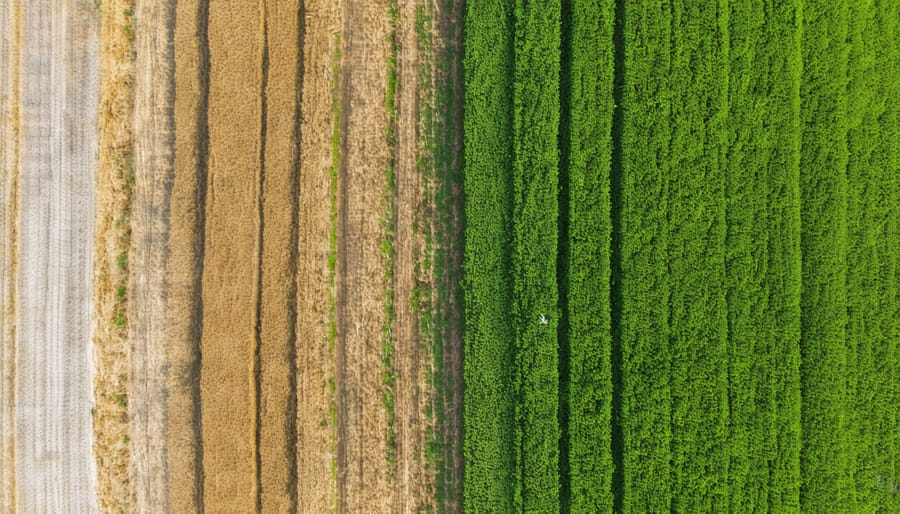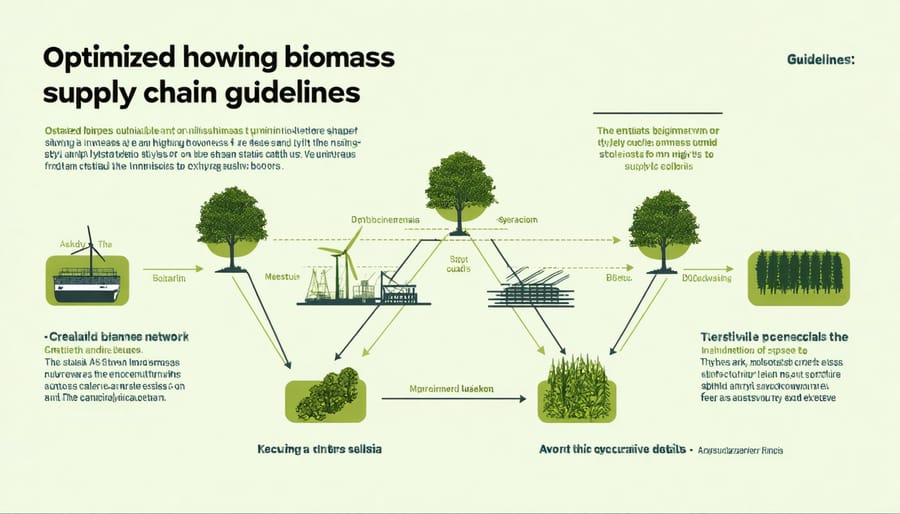Supply chain optimization revolutionizes how businesses transform raw materials into finished products, driving efficiency from warehouse to customer doorstep. In today’s hyperconnected marketplace, where biomass resources in Australia and global commodities flow across complex networks, mastering supply chain optimization has become crucial for survival. Through advanced analytics, artificial intelligence, and real-time tracking systems, companies can now predict demand patterns, minimize inventory costs, and respond instantly to market fluctuations. This strategic approach doesn’t just cut operational expenses—it creates resilient, sustainable business models that thrive in uncertain times. Whether you’re a startup scaling operations or an established enterprise seeking competitive advantage, understanding supply chain optimization unlocks the power to deliver products faster, reduce waste, and exceed customer expectations while maintaining healthy profit margins.
Why Biomass Supply Chains Need Special Attention
The Seasonal Nature of Biomass
The cyclical nature of biomass availability presents unique challenges for supply chain optimization in Australia. Agricultural residues and energy crops follow strict seasonal patterns, with harvest windows typically occurring just once or twice per year. For instance, sugarcane bagasse becomes available during the crushing season from June to December in Queensland, while wheat straw is harvested during the summer months across the southern states.
This seasonality necessitates careful planning and robust storage solutions. Biomass materials must be properly stored to maintain their energy value and prevent degradation from moisture, pests, and microbial activity. Modern storage facilities, such as covered bunkers and sealed silos, help preserve biomass quality while ensuring year-round availability for power generation.
Smart scheduling of harvests and deliveries becomes crucial to maintaining consistent supply throughout the year. Many Australian bioenergy facilities have adopted sophisticated inventory management systems that track moisture content, energy value, and storage conditions. These systems help operators balance seasonal influxes with steady demand, ensuring efficient operation even during off-peak harvest periods. Success stories like the Mackay Renewable Biocommodities Pilot Plant demonstrate how proper seasonal management can create a reliable, year-round biomass supply chain.

Geographic Distribution Challenges
Australia’s vast landscape presents unique challenges for biomass supply chain optimization. The scattered nature of agricultural and forestry resources means collection points can be hundreds or even thousands of kilometers apart, significantly impacting transportation costs and logistics planning.
In regions like Western Australia and Queensland, the tyranny of distance becomes particularly evident. Agricultural waste collectors must navigate extensive road networks, often dealing with unsealed roads and varying seasonal conditions. During the wet season in tropical areas, access to collection sites can become severely limited, requiring careful timing and alternative route planning.
The concentration of processing facilities near major population centers creates additional complexities. Biomass sources in remote areas face higher transportation costs, potentially making otherwise viable resources economically unfeasible. To address these challenges, successful operations often employ hub-and-spoke collection systems, establishing regional collection points that consolidate materials before long-haul transport.
Innovation in mobile processing technology is helping overcome these geographic barriers. Portable pelletizing units and mobile chippers are increasingly being deployed to remote locations, reducing transportation volumes and costs while maximizing resource utilization.

Core Elements of Biomass Supply Chain Optimization
Collection and Storage Solutions
Effective collection and storage of biomass materials form the backbone of a well-optimized supply chain. In Australia, successful biomass operations rely on carefully planned harvesting schedules and purpose-built storage facilities that protect valuable feedstock from weather damage and degradation.
The ‘just-in-time’ collection approach has proven particularly effective for agricultural residues, coordinating harvests with processing needs to minimize storage requirements. Many facilities now employ satellite tracking and predictive analytics to optimize collection routes and timing, reducing both fuel costs and environmental impact.
Modern storage solutions include moisture-controlled warehouses and innovative silo designs that maintain optimal conditions for different biomass types. These facilities are equipped with advanced biomass processing technologies for pre-treatment and sorting, ensuring consistent quality throughout storage periods.
Best practices include:
– Covered storage areas with proper ventilation
– Regular moisture content monitoring
– Strategic placement of storage facilities near collection points
– Implementation of inventory management systems
– Quality control measures at collection and storage points
Leading Australian facilities have found success with modular storage solutions that can be scaled according to seasonal variations in biomass availability. This flexibility, combined with smart logistics planning, helps maintain a steady supply for processing while minimizing waste and storage costs.
Transport Network Design
Transport network design plays a crucial role in optimizing supply chains, especially in a vast country like Australia where materials and products often travel significant distances. By carefully planning transportation routes and modes, organizations can reduce costs, minimize environmental impact, and improve delivery times.
Efficient transport networks begin with strategic facility locations and hub placement. Companies analyze factors such as proximity to suppliers, customers, and existing infrastructure to determine optimal distribution points. This helps create a network that minimizes travel distances while maximizing coverage.
Route optimization is another key component, utilizing advanced algorithms to determine the most efficient paths between points. These systems consider various factors including fuel consumption, delivery windows, vehicle capacity, and road conditions. In practice, this might mean combining multiple deliveries into single trips or selecting alternative routes during peak traffic hours.
Modern transport network design also emphasizes sustainability. Organizations increasingly adopt multi-modal transportation strategies, combining road, rail, and sea transport to reduce carbon emissions. This approach has proven particularly effective in Australia’s resource sector, where companies coordinate different transport methods to move materials from inland locations to coastal ports.
Real-time tracking and dynamic routing capabilities allow networks to adapt to changing conditions, such as weather events or road closures. This flexibility ensures consistent service levels while maintaining efficiency, making transport networks more resilient and reliable.
Processing Facility Location
The strategic placement of processing facilities plays a pivotal role in creating an efficient and sustainable biomass supply chain. In Australia’s vast landscape, choosing the right location can significantly impact both operational costs and environmental footprint. Smart facility positioning considers multiple factors, including proximity to biomass sources, transportation networks, and end-users.
A well-planned facility location can reduce transportation distances by up to 40%, leading to lower fuel consumption and decreased carbon emissions. For instance, facilities positioned near agricultural regions can efficiently process crop residues, while those near urban centres can focus on biomass waste management from municipal sources.
Recent innovations in Geographic Information System (GIS) technology have revolutionised facility placement decisions. These tools analyse factors such as existing infrastructure, road networks, and biomass availability to identify optimal locations. Success stories from Queensland demonstrate how strategic facility placement near sugar cane fields has reduced transportation costs by 35% while cutting emissions significantly.
The best practice approach involves creating a network of smaller, strategically placed processing facilities rather than centralising operations in one large facility. This distributed model not only reduces transportation requirements but also creates local employment opportunities and strengthens regional economies. Additionally, it provides greater resilience against supply chain disruptions and seasonal variations in biomass availability.
Technology’s Role in Supply Chain Optimization
Digital Supply Chain Tools
Modern supply chain optimization relies heavily on sophisticated digital tools that streamline operations and enhance decision-making. Leading the pack are Enterprise Resource Planning (ERP) systems, which serve as the backbone of supply chain management by integrating various business processes into a single, unified platform.
Cloud-based supply chain management solutions have revolutionized how organizations track and manage their operations in real-time. These platforms offer unprecedented visibility across the entire supply network, from raw material sourcing to final delivery. They enable quick responses to disruptions and help maintain optimal inventory levels.
Advanced analytics and artificial intelligence tools now play a crucial role in forecasting demand, optimizing routes, and predicting potential bottlenecks. Machine learning algorithms can process vast amounts of historical data to identify patterns and suggest improvements, while predictive analytics help organizations stay ahead of market changes.
Internet of Things (IoT) sensors and devices provide real-time tracking and monitoring capabilities, offering valuable insights into product conditions, location, and delivery status. This technology is particularly valuable for temperature-sensitive materials and time-critical deliveries.
Digital twins – virtual replicas of physical supply chains – allow organizations to simulate different scenarios and test optimization strategies without disrupting actual operations. This innovative approach helps identify potential improvements and assess risks before implementing changes in the real world.
These digital tools work together to create a more resilient, efficient, and sustainable supply chain ecosystem that can adapt to changing market conditions and customer demands.

Real-time Monitoring Solutions
Modern technology has revolutionised how we monitor biomass supply chains in real-time, making operations smoother and more efficient than ever before. In Australia, innovative monitoring solutions are helping facility managers track both quality and quantity of biomass materials from source to final delivery.
Smart sensors and IoT devices installed throughout the supply chain provide continuous data streams on crucial parameters like moisture content, temperature, and material volume. These devices, strategically placed in storage facilities and transport vehicles, help prevent quality degradation and optimize storage conditions.
Leading Australian biomass facilities are now using drone technology and satellite imaging to monitor feedstock sources, helping them predict supply volumes and plan harvesting schedules. Mobile apps enable truck drivers to log collection and delivery information instantly, while providing real-time updates on route optimization and delivery schedules.
Quality control stations equipped with near-infrared spectroscopy (NIRS) technology can rapidly assess biomass properties, ensuring consistent quality meets specifications. Meanwhile, blockchain technology is emerging as a game-changer, creating an unalterable record of biomass movement and quality parameters throughout the supply chain.
These monitoring solutions not only improve operational efficiency but also help maintain transparency and traceability. For example, the Mount Gambier biomass facility uses an integrated monitoring system that has reduced waste by 15% and improved delivery accuracy by 25%. This real-time visibility helps managers make informed decisions quickly, ensuring smooth operations while maintaining the highest quality standards.
Success Stories: Australian Biomass Supply Chain Optimization
The transformation of Australia’s biomass supply chain has yielded remarkable success stories, demonstrating the power of strategic optimization. One standout example is the Mount Gambier Timber Processing Hub, which revolutionized its operations by implementing an integrated supply chain management system. This initiative reduced waste by 40% while increasing production efficiency by 25%, proving that Australian biofuel innovations can deliver both environmental and economic benefits.
In Queensland’s sugar cane industry, the Mackay Renewable Bioenergy Facility showcased how smart logistics can transform agricultural waste into gold. By optimizing collection routes and implementing real-time tracking systems, they reduced transportation costs by 35% while ensuring a steady supply of bagasse for energy production. This success has inspired similar projects across the sugar belt, creating a ripple effect of positive change.
The Western Australian Wheatbelt region presents another inspiring case study. Local farmers collaborated with energy producers to establish a coordinated biomass collection network. Using mobile apps and AI-driven scheduling, they transformed scattered agricultural residues into a reliable energy source. The project not only created new income streams for farmers but also reduced carbon emissions by replacing fossil fuels with renewable alternatives.
Perhaps most impressive is the Victorian Forest-to-Energy Initiative, which demonstrates the power of partnership in supply chain optimization. By bringing together forestry operations, transportation companies, and energy producers under a unified digital platform, they achieved a 50% reduction in supply chain bottlenecks. The initiative now serves as a blueprint for sustainable biomass energy production across the country.
These success stories highlight how thoughtful optimization strategies, coupled with modern technology and collaborative approaches, can unlock the full potential of Australia’s biomass resources. They prove that with the right systems in place, sustainable energy production can be both environmentally responsible and economically viable.
As Australia continues to embrace renewable energy solutions, biomass supply chain optimization stands as a crucial cornerstone for our sustainable future. The journey toward efficient bioenergy production has shown remarkable progress, with innovative technologies and strategic partnerships leading the way.
The success stories from regions like Western Australia’s wheat belt and Victoria’s forestry sector demonstrate that well-optimized biomass supply chains can deliver both environmental and economic benefits. These achievements have set a promising precedent for future developments across the nation.
Looking ahead, the outlook for biomass supply chain optimization in Australia is particularly bright. Advanced analytics, artificial intelligence, and blockchain technology are set to revolutionize how we track, manage, and optimize biomass resources. These innovations will help reduce costs, minimize waste, and enhance overall efficiency throughout the supply chain.
The growing collaboration between farmers, industry players, and research institutions signals a robust foundation for future growth. As more organizations recognize the value of sustainable practices, we can expect to see increased investment in supply chain optimization technologies and processes.
The key to success lies in maintaining this momentum while focusing on continuous improvement. By embracing digital solutions, fostering industry partnerships, and supporting local initiatives, Australia is well-positioned to become a global leader in biomass supply chain optimization. This transformation will not only contribute to our renewable energy targets but also create new opportunities for regional communities and sustainable business practices.
Together, we can build a more sustainable and efficient bioenergy sector that serves as a model for the rest of the world.

